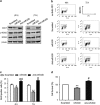MiR-630 inhibits proliferation by targeting CDC7 kinase, but maintains the apoptotic balance by targeting multiple modulators in human lung cancer A549 cells
- PMID: 25255219
- PMCID: PMC4225225
- DOI: 10.1038/cddis.2014.386
MiR-630 inhibits proliferation by targeting CDC7 kinase, but maintains the apoptotic balance by targeting multiple modulators in human lung cancer A549 cells
Abstract
MicroRNAome analyses have shown microRNA-630 (miR-630) to be involved in the regulation of apoptosis. However, its apoptotic role is still debated and its participation in DNA replication is unknown. Here, we demonstrate that miR-630 inhibits cell proliferation by targeting cell-cycle kinase 7 (CDC7) kinase, but maintains the apoptotic balance by targeting multiple activators of apoptosis under genotoxic stress. We identified a novel regulatory mechanism of CDC7 gene expression, in which miR-630 downregulated CDC7 expression by recognizing and binding to four binding sites in CDC7 3'-UTR. We found that miR-630 was highly expressed in A549 and NIH3T3 cells where CDC7 was downregulated, but lower in H1299, MCF7, MDA-MB-231, HeLa and 2BS cells where CDC7 was upregulated. Furthermore, the induction of miR-630 occurred commonly in a variety of human cancer and immortalized cells in response to genotoxic agents. Importantly, downregulation of CDC7 by miR-630 was associated with cisplatin (CIS)-induced inhibitory proliferation in A549 cells. Mechanistically, miR-630 exerted its inhibitory proliferation by blocking CDC7-mediated initiation of DNA synthesis and by inducing G1 arrest, but maintains apoptotic balance under CIS exposure. On the one hand, miR-630 promoted apoptosis by downregulation of CDC7; on the other hand, it reduced apoptosis by downregulating several apoptotic modulators such as PARP3, DDIT4, EP300 and EP300 downstream effector p53, thereby maintaining the apoptotic balance. Our data indicate that miR-630 has a bimodal role in the regulation of apoptosis in response to DNA damage. Our data also support the notion that a certain mRNA can be targeted by several miRNAs, and in particular an miRNA may target a set of mRNAs. These data afford a comprehensive view of microRNA-dependent control of gene expression in the regulation of apoptosis under genotoxic stress.
Figures







References
-
- Johnston LH, Masai H, Sugino A. First the CDKs, now the DDKs. Trends Cell Biol. 1999;9:249–252. - PubMed
-
- Sclafani RA. Cdc7p-Dbf4p becomes famous in the cell cycle. J Cell Sci. 2000;113 (Part 12:2111–2117. - PubMed
-
- Hughes S, Elustondo F, Di Fonzo A, Leroux FG, Wong AC, Snijders AP, et al. Crystal structure of human CDC7 kinase in complex with its activator DBF4. Nat Struct Mol Biol. 2012;19:1101–1107. - PubMed
-
- Dowell SJ, Romanowski P, Diffley JF. Interaction of Dbf4, the Cdc7 protein kinase regulatory subunit, with yeast replication origins in vivo. Science. 1994;265:1243–1246. - PubMed
Publication types
MeSH terms
Substances
LinkOut - more resources
Full Text Sources
Other Literature Sources
Medical
Research Materials
Miscellaneous

